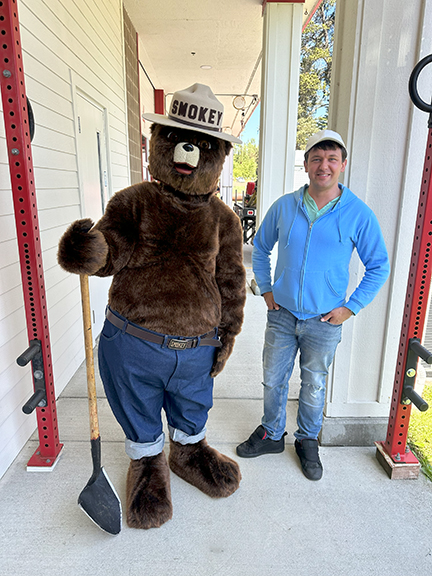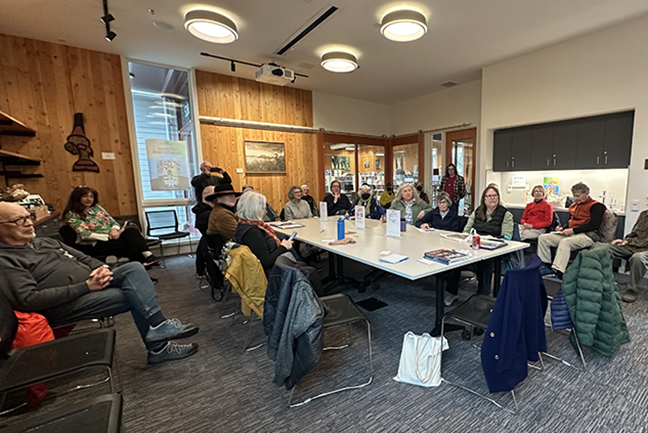Wildfire Ready Neighbors Program is *STILL* Ready to Help You Make Your Home More Fire-Resilient
RE-POSTED Monday, June 24, 2024
With increased wildfires across Washington and British Columbia, including a larger wildfire last week on the Skagit/Snohomish County border near Darrington, we checked with the DNR to make sure San Juan residents can still request home inspections for wildfire risk mitigation on your property.
You can. The information in CNL2’s May 19 article is still current.
THIS ITEM WAS ORIGINALLY POSTED ON CNL2 on Sunday, May 19, 2024
A CNL2 VIDEO IS AT THE BOTTOM OF THIS PAGE
The Wildfire Ready Neighbors Program is now available to San Juan County property owners. The program provides a free risk assessment of your property led by a local wildfire expert. Wildfires are more common now, and they can be more intense and destructive. In April, the Washington Department of Ecology declared a drought emergency for most of the state.
In opening remarks at the May 8 kickoff, DNR’s Jennifer Coe said, “This program is not just about clearing brush, or maintaining roofs. It’s really about fostering a sense of shared responsibility. And the more we can work together as neighbors and communities, the better we can help prevent, withstand and recover from wildfire.”
Since the program’s inception in 2021, more than 30,000 action plans in 11 counties have been completed.
In San Juan County, the program has very wide buy-in. The list of partners includes:
- San Juan Island Fire & Rescue
- Orcas Island Fire & Rescue
- Lopez Island Fire & EMS
- Shaw Island Fire & Rescue
- Waldron Island Emergency Brigade
- Decatur Island Emergency Brigade
- San Juan County Emergency Management
- San Juan County Fire Marshal’s Office
- Opalco
- National Park Service
- San Juan Islands Conservation District

Several private citizens attended the event and asked questions after the presentation. Current and past County Council members and Commissioners of various county departments were also present.
Paul Anderson, Executive Director for the San Juan Islands Conservation District, spoke of “a small army of our people have been trained up and will be engaged in going out to all the islands…doing these site assessments.”
He said the small army includes, “the local Islands Conservation Corps. They’ve grown to a really legitimate higher education workforce training program in partnership with Western Washington University.”
Anderson spoke of alarming amounts of potential wildfire “fuel” in the San Juans. He said, “We live in a fire-adapted ecosystem, which has changed dramatically over the past 100 years. What we’re left with are heavily overstocked forests. They’re not healthy. And they’re not happy either. In a study done by the Northwest Natural Resource Group — looking at the woody biomass that’s out on the landscape in the San Juan Islands — they ascertained that there were…
- 3 million tons of excess biomass in the San Juan Islands
- 540,000 tons in the wild land-urban interface alone that could all be extracted
“And it’s pretty much sitting there as fuel, or soaking up nutrients and water and detracting from the health of the rest of the forest surrounding.”
Josh Etringer, Assistant Fire Unit Manager of the DNR’s Northwest Region spoke of how wildfire-prepared properties help firefighters get more done in a wildfire. He said, “If and when we get fires out here, your guys’ homes are going to be more resilient to the fire… So when we come through and do our firefighting efforts, it’s going to make our job a lot easier.”
After speeches and Q&A at the firehouse, the event continued with homeowner and EMT-firefighter Adam Greene at Oak Knoll Farm on Douglas Rd., where San Juan Island Fire & Rescue’s Kathleen Salinas conducted a sample site assessment for onlookers and the press.
San Juan Island Fire & Rescue Chief Noel Monin commended the program because he said, “It empowers folks to do things on their own to make their homes more fire resilient.”
He said funding for the local agencies and departments to conduct these assessments and develop these action plans is being provided by a grant from the State Department of Natural Resources.
To request your site assessment and action plan, click here.
This CNL2 video is approximately 4-1/2 minutes in duration.






